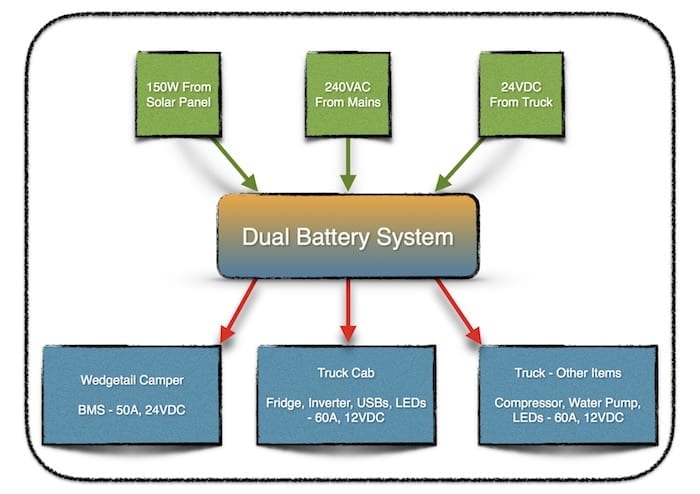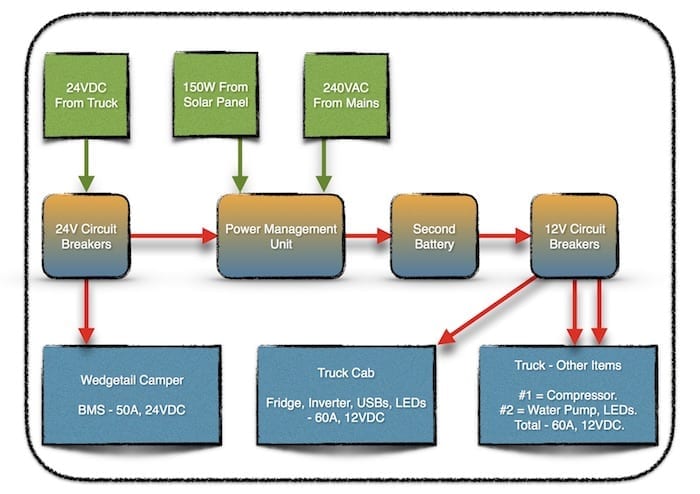What Parts Do I Need For My Dual Battery System?
Last time we looked at how to figure out what you need when specifying a dual battery system. Go here for more details.

This time we’ll look at the parts you’ll need to make it all work properly. We’ll keep using our Isuzu NPS expedition vehicle as our example. Remember, our setup is a little more complicated – the truck runs 24 volts, but we want a 12 volt dual battery system.
What’s Inside The “Dual Battery System” Box?
Last time, we ended with a flow chart showing all the missing bits we’ll need. Here it is again.

We need to specify exactly what’s inside the mystery “Dual Battery System” box. So let’s get started.
We’ve taken the above flow chart and pulled it apart:
- Split up 12V and 24V systems.
- Added circuit breakers.
- Shown the second battery and a “Power Management Unit”.

So now we’re much closer to a solution. It’s becoming much clearer what parts we need.
Heart Of The System
The “Power Management System” is the heart of the system. Have a good look at what we’re asking it to do:
- Manage 3 incompatible power sources – solar, 24VDC and 240VAC.
- Charge the second battery and maintain it in an optimal state.
- Be able to charge different types of batteries. Why? Because the gel battery we are using is pretty old. When it dies, we’ll replace it with a lithium battery.
- Isolate the truck batteries (2 x 12V in series to make 24V) when they reach a low threshold voltage.
- Do all this whilst being shaken, bounced and vibrated from one end of the country to the other.
We could use several components to achieve all of the above – a battery charger, a DC to DC charger, an isolator, a solar regulator and so on. But there is a unit that will do all of the above and more.
It’s the REDARC Battery Management System Manager 30 (BMS1230S2).
After spending ages researching what’s available, the Manager 30 is a standout. At first, the price tag is a shock. But when you add up the cost of the all of the components needed to do the same job, it’s actually quite a bit cheaper. And REDARC equipment is premium quality and is made in Australia.
What Else Do We Need?
We decided to install 2 banks of circuit breakers – one for 12V and the second for 24V. Each bank has a main on/off isolation switch. This is a neat and compact solution.

What else? Lots of Anderson plugs, the correct sized cabling and fuses. (Go here for details on automotive wiring and our handy Cable Size Calculator).
Fuses? Yep. A 100A blade fuse on the supply from the truck batteries, another 100A fuse on the supply from the second battery and a 40A fuse on the supply from the BMS to the second battery.
So why do we have a mix of circuit breakers and fuses? Well, circuit breakers conveniently double as on/off switches. However they can sometimes trip at a current higher than their rating. Therefore the cables out of the circuit breakers have been rated well above the respective circuit breaker’s rated current.
Fuses are used where it’s vital to protect the cables from over-current. The last thing we want is a cable fire. Also, the fuses need to be mounted as close to the power source as possible. Individual fuses are far easier to mount than circuit breakers.
So there you have it. Next time we’ll look at laying out the equipment and some handy tips.
My Generator has a wide range of REDARC gear, including the Manager30.
NOTE: REDARC send us products to review from time to time. (That said, we purchased all REDARC products mentioned in this article.)

Get your Traveller’s Guides
… and a whole lot more at our FREE RESOURCES Page!
Any questions or comments? Go to the Comments below or join us on Pinterest, Facebook or YouTube.
Any errors or omissions are mine alone.
Go here for more How-To Guides and tips.
